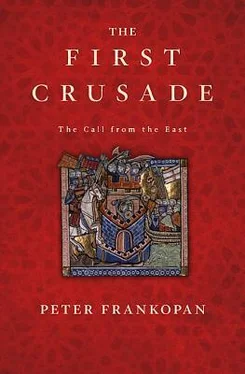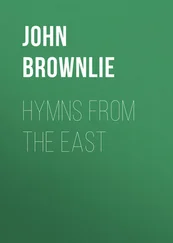3 Stability in the East
1. I. Mélikoff (ed.), La geste de Melik Danismend , 2 vols. (Paris, 1960). • 2. When Alexios was sent to reassert the emperor’s authority over Balliol in the mid1070s, the inhabitants of Amaseia booed and jeered him when he took the Norman prisoner. Anna Komnene, I.2, pp. 11–13. • 3. Matthew of Edessa, II.72, p. 144. • 4. J-C. Cheynet and D. Theodoridis, Sceaux byzantins de la collection D. Theodoridis (Paris, 2010), pp. 26–8. • 5. Nikephoros Palaiologos still held this position in 1081. Nikephoros Bryennios, III.15, p. 239. • 6. J-C. Cheynet and J-F. Vannier, Etudes Prosopographiques (Paris, 1986), pp. 57–74; Cheynet and Theodoridis, Sceaux byzantins , pp. 54– 6; C. MacEvitt, The Crusades and the Christian World of the East: Rough Tolerance (Philadelphia, 2008), pp. 41–2. • 7. For example, Michael Angold, The Byzantine Empire 1025 – 1204 (London, 1984), pp. 112–13; France, Victory in the East , pp. 155–6; J. Flori, La Première Croisade: l’Occident chrétien contre l’Islam aux origines des idéologies occidentales (Paris, 2001), p. 64; P. Magdalino, ‘The Medieval Empire (780–1204)’ in C. Mango (ed.), The Oxford History of Byzantium , p. 185; J. Harris, Byzantium and the Crusades (London, 2003), pp. 47, 55. Phillips, Holy Warriors , p. 15. • 8. Anna Komnene, III.9, p. 100. • 9. Ibid. • 10. Anna Komnene, II.6, p. 65. • 11. Anna Komnene, II.3, pp. 54–5. • 12. J. Darrouzès, Notitiae episcopatuum ecclesiae constantinopolitanae (Paris, 1981), pp. 123–4, 134–5. • 13. J-C. Cheynet, ‘La résistance aux Turcs en Asie Mineure entre Mantzikert et la Première Croisade’, in Eupsykhia: Mélanges offerts à Hélène Ahrweiler , 2 vols. (Paris, 1998), 1, pp. 131–47. • 14. For Alexios’ fears about his own troops in 1081, Anna Komnene, II.9, p. 71; for the circumstances behind the belated coronation of Alexios’ wife, Eirene, III.2, pp. 81–4. • 15. Anna Komnene, III.5, pp. 89–91. • 16. Anna Komnene, III.11, p. 104. • 17. For example, Nikephoros Bryennios, III.16, p. 241; IV.2, p. 259. • 18. Nikephoros Bryennios, IV.4, p. 265; IV.10–13, pp. 275–9. • 19. J. Darrouzès (ed.), Georges et Dèmètrios Tornikès – Lettres et Discours (Paris, 1970), pp. 234–5. • 20. Orderic Vitalis, X.12, 5, p. 274. • 21. For the capture of Tatikios’ father, Anna Komnene, IV.4, p. 115. • 22. Anna Komnene, III.11, p. 105. • 23. Anna Komnene, V.5.ii, p. 140. • 24. Anna Komnene, IV.4, p. 115; IV.6, p. 123; V.6.iv, p. 159; William of Apulia, IV, pp. 222, 226. • 25. Anna Komnene, VI.12, p. 177. • 26. Matthew of Edessa, II.78, pp. 147–8. • 27. Bar Hebraeus, ed. and tr. E. Budge, The Chronography of Gregory Abul Faraj , 2 vols. (Oxford, 1932), 2, p. 227. • 28. De Administrando Imperio, ed. and tr. G. Moravcsik and R. Jenkins, (Washington DC, 1967). • 29. Nikephoros Bryennios, IV.31, p. 301. • 30. P. Frankopan, ‘The Fall of Nicaea and the towns of western Asia Minor to the Turks in the later 11th Century: The curious case of Nikephoros Melissenos’, Byzantion 76 (2006), pp. 153–84, and below, p. 82. • 31. For the empress’s commissioning of Nikephoros’ history, Nikephoros Bryennios, pp. 71–3; Anna Komnene, Prologue, p. 5. • 32. After 1081, he is referred to as the ‘emir’ (i.e. governor) of Nicaea. Anna Komnene, VI.9, pp. 169–70. Anna also states that his quarters in Nicaea were those of the emperor, though in Turkish they were called those of the sultan, III.11, p. 104. Michael Attaleiates, writing at the very end of the 1070s, does not refer to him with a title, calling him a Turkish leader, p. 266. Nikephoros Bryennios avoids using a title when writing about Sulayman for the period before 1081, e.g. III.16, p. 241. • 33. The two exceptions are the Alexiad, and the Epitome Historion of John Zonaras. A third author writing in the twelfth century, Michael Glykas, covers Alexios’ reign, though this is copied verbatim from Zonaras’ work. • 34. See P. Magdalino, ‘Aspects of twelfth-century Byzantine Kaiserkritik’,Speculum 58 (1983), pp. 326–46. • 35. Albert of Aachen, II.28, p. 108. • 36. Ekkehard of Aura, p. 200. • 37. See J-C. Cheynet, ‘The duchy of Antioch during the second period of Byzantine rule’, in K. Ciggaar and D. Metcalf (eds.), East and West in the Medieval Eastern Mediterranean: Antioch from the Byzantine Reconquest until the End of the Crusader Principality (Leiden, 2006), pp. 1–16. • 38. Michael Attaleiates, p. 301. • 39. Lead seals belonging to Philaretos that attest to him as protosebastos and commander of the armies of the eastern provinces, must date to after 1081, as the title of protosebastos was first introduced by Alexios. This in turn shows that the emperor looked to Philaretos in the east, and rewarded him with greater status. J-C. Cheynet, C. Morrisson and W. Seibt, Les Sceaux byzantins de la collection Henri Seyrig (Paris, 1991), no. 192; Cheynet and Theodoridis, Sceaux byzantins, pp. 54–6. Other dignities from this period show how he was courted, for example, J-C. Cheynet, ‘Sceaux byzantins des Musées d’Antioche et de Tarse’, Travaux et Mémoires 12 (1994), no. 56. • 40. Anna Komnene, VI.9, pp. 169–70. • 41. Matthew of Edessa, II.60, p. 137. • 42. Anonymi Auctoris Chronicon ad Annum Christi 1234Pertinens , tr. A. Abouna and J-M. Fiey, Chronicle of the Unknown Edessan (Paris, 1974), p. 39. • 43. J-C. Cheynet, ‘Les Arméniens de L’Empire en Orient de Constantin Xe à Alexis Comnène (1059–1081)’, L’Arménie et Byzance (Paris, 1996), p. 76. • 44. Michael the Syrian, 3, p. 178. • 45. Matthew of Edessa, II.78, p. 147; also Anna Komnene, VI.9, p. 170. • 46. Ibn al-Ahtir, AH 477/Dec. 1084–Dec. 1085, p. 218; Sibt ibn al-Jawzi, Mir’at al-Zaman fi Ta’rikh al-A’yan , ed. A. Sevim (Ankara, 1968), p. 229. • 47. Ibn al-Athir, quoting the poet al-Abirwardi, AH 477/Dec. 1084– Dec. 1085, p. 218. • 48. Ibid., pp. 218–19. • 49. Ibn al-Athir, AH 479/Dec. 1086–Dec. 1087, p. 223. • 50. Ibn al-Athir, AH 477/Dec. 1084–Dec. 1085, p. 224; Sibt ibn al-Jawzi, p. 229. • 51. Anna Komnene, VI.10, p. 171. • 52. The History of the Seljuk Turks from the Jami’ak-Tawarikh , tr. K. Luther (Richmond, 2001), pp. 62, 60–1. • 53. Anna Komnene, VI.12, pp. 177–8. The letter was written following the Byzantine defeat of Robert Guiscard’s attack on Epirus, and before the major Pecheneg invasion of 1087. • 54. Anna Komnene, VI. 9, pp. 170–1. Anna splits the report of the sultan’s proposal in two. • 55. Anna Komnene, VI.12, p. 178. • 56. Anna Komnene, VIII.3, p. 220. • 57. Anna Komnene, VI.9, p. 171. • 58. Bar Hebraeus, 2, p. 229. • 59. Ibn al-Athir, AH 485/ Dec. 1091–Dec. 1092, p. 259. • 60. Anna Komnene, VI.12, p. 177. • 61. Matthew of Edessa, II.86, p. 153. • 62. Ibid. • 63. The reply to the sultan’s queries survives. P. Gautier, ‘Lettre au sultan Malik-Shah rédigée par Michel Psellos’, Revue des Etudes Byzantines 35 (1977), pp. 73–97. • 64. Matthew of Edessa, II.86, p. 153. • 65. Little is known about the kouropalates T’oros, or Gabriel, governors of Edessa and Melitene respectively in this period, or about whether they accepted (or were induced to accept) the authority of Malik-Shah. However, given Matthew of Edessa’s scathing comments about Philaretos Braakhamios, and his decision to join the sultan and turn to Islam, we might expect the same vilification in his chronicle had these two men defected to the Turks. Matthew of Edessa, II.85, pp. 152–3. Gabriel seems to have hedged his bets, however, issuing a seal attesting to him with both Byzantine and Arabic titles. J-C. Cheynet, Sceaux de la collection Zacos se rapportant aux provinces orientales de l’Empire byzantine (Paris, 2001), no. 41. • 66. Anna Komnene, VI.10, p. 172. • 67. Anna Komnene, VI.13, pp. 180–2. • 68. Ibid., p. 181; VI.14, pp. 183–4. Humbertopoulos’ transfer to the west dates the recovery of the town. • 69. Anna Komnene, VI.13, pp. 180–2. • 70. Theophylact of Ohrid, pp. 113–14. Theophylact’s comments were delivered in a speech to the emperor made just over a year later. • 71. Ibid., p. 111.
Читать дальше











